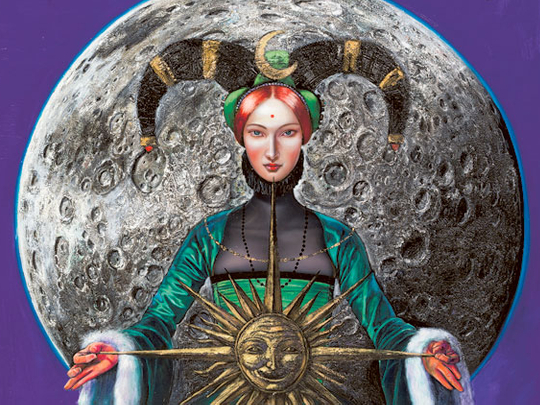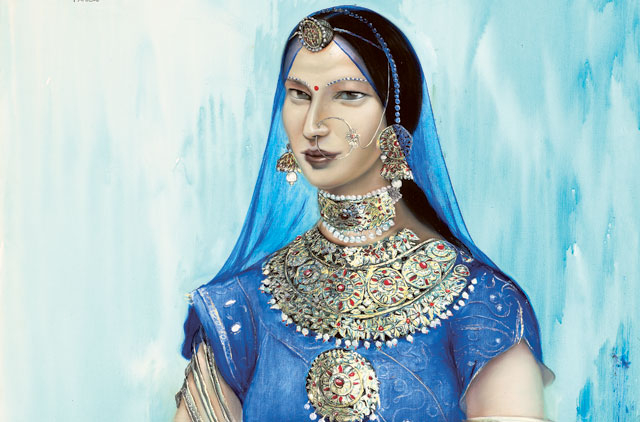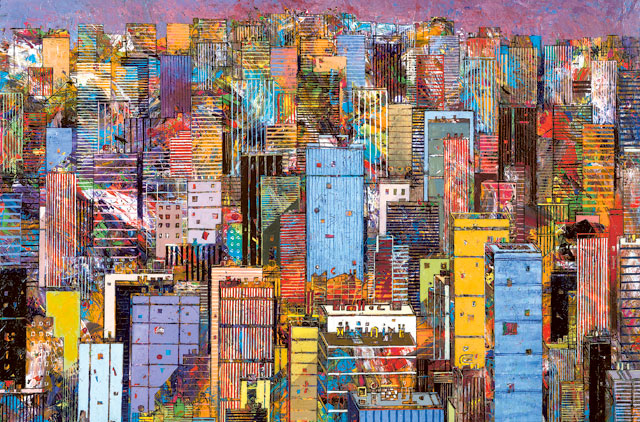
The latest show at Opera gallery, titled ‘The French Connection’, features works by French artists Patrick Boussignac and Jean-Francois Larrieu. The two artists have very different styles.
Boussignac’s background as an illustrator and caricaturist is evident in his figurative oil paintings featuring characters from comics, history, religion, literature and mythology. The artist freely mixes different cultures and eras in his intriguing compositions, giving a twist to familiar tales and creating narratives that viewers from around the world can relate to.
The people in his paintings are inspired by famous faces such as the Mona Lisa, Russian Czars, Egyptian goddesses and African warriors. But his Mona Lisa is dressed in traditional Indian attire, and the Greek mythological character Damocles has Japanese features.
Influences of various cultures can be seen in his clothes too, with only the sword hanging over his head offering a clue to his identity. Many of Boussignac’s paintings are inspired by 18th- and 19th-century art, such as “Les Demoiselles D’Avignon” — a composition based on Picasso’s famous painting of the same name, but with the women dressed in modern attire. Ask him about the meaning of his compositions and his cryptic reply is, “What if the art of painting was only an extension of our illusion that everything surrounding us has meaning?”
On the other hand, Jean-Francois Larrieu’s favourite subjects are rural and urban landscapes, flora and fauna. His acrylic paintings are bursting with bright colours and a plethora of details. The artist was in Dubai for the opening of the show, and spoke to Weekend Review about his style, his inspirations and his world view. Excerpts:
Why do you use so many bright colours in all your paintings?
My love for these warm Mediterranean colours is influenced by my mother, who is Spanish. I use these colours because I want my paintings to be full of life, energy and goodness. I look only at the good in everything around us, and I want to express this positive point of view in my work. Colours and abstraction help me to convey my personal view of the world in a language that can be universally understood.
What do the hundreds of tiny abstract details in your paintings represent?
If you take the time to look, you will find that a tree, fish or human being are all made up of many minute details that combine in different ways to make them what they are. I marvel at the perfection of these tiny details in nature and how they all come together to create different forms of life, and I want to show that in the trees, fish and other creatures I paint.
In my cityscapes, the abstract elements represent the people who are the source of the city’s life and energy. Other abstract elements in my paintings represent the planets, moons and constellations of the imaginary universe that I want to depict. The same elements inside the fish, butterflies and trees show that within even the simplest of living creatures there exists an entire universe that is complex and beautiful.
Many of your paintings feature butterflies. Why are you so fascinated by this subject?
Butterflies are small, but they are so beautiful and perfect. That they have such a short life span is a message to us that life is beautiful but fragile and vulnerable. Instead of wasting time on wars and negativity, we should focus on the beauty around us and the good in every person.
What is the meaning of the checked pattern and the doors and windows that appear in all your paintings?
The “damier” or checkerboard is a symbol of the code that you must know to understand my universe. Some of the doors and windows are closed to keep viewers wondering about what lies behind them, whereas the open doors and windows are a means to escape from the crowded cities in my cityscapes or to look beyond the world presented on my canvases.
How has Dubai inspired you?
I love the city and its architecture, and many of my paintings in this series have been inspired by Dubai such as “Zabeel Park”, “The Palms”, “Hand of Fatima”, and “The Great Whale”, which is based on the fish I saw at the aquarium in Dubai Mall. In my Dubai cityscapes I always make the palm tree taller than the buildings because to me that is the true symbol of Dubai.
How do you see your work evolving?
I have been experimenting with three-dimensional cityscapes created with layers of Plexiglas and a 3D wall piece and a table are on display in this show. I am also interested in seeing whether the abstract elements and code in my paintings will work without colour. The single black-and-white painting in this show signals a new direction in my work.
Jyoti Kalsi is an arts enthusiast based in Dubai.




